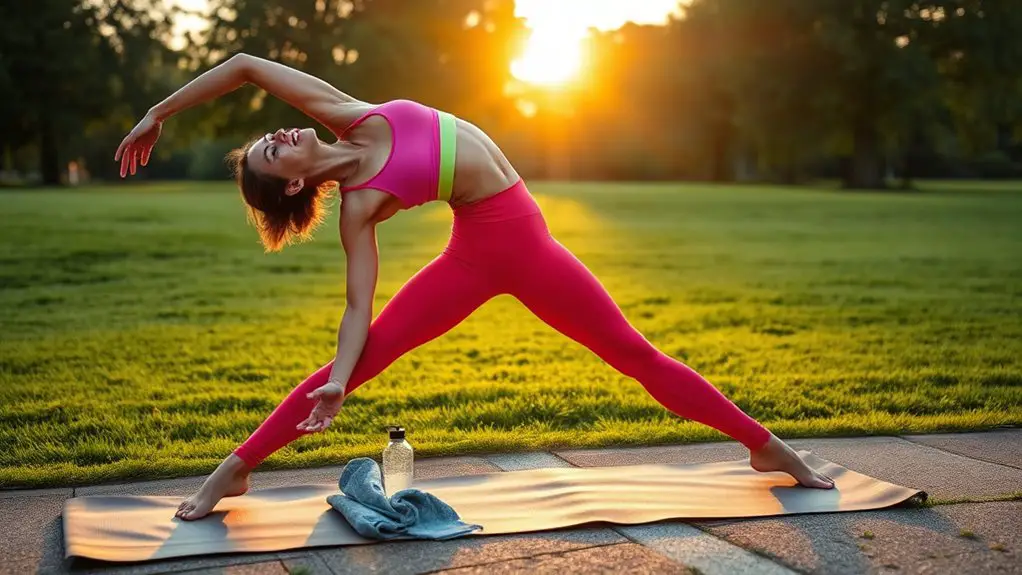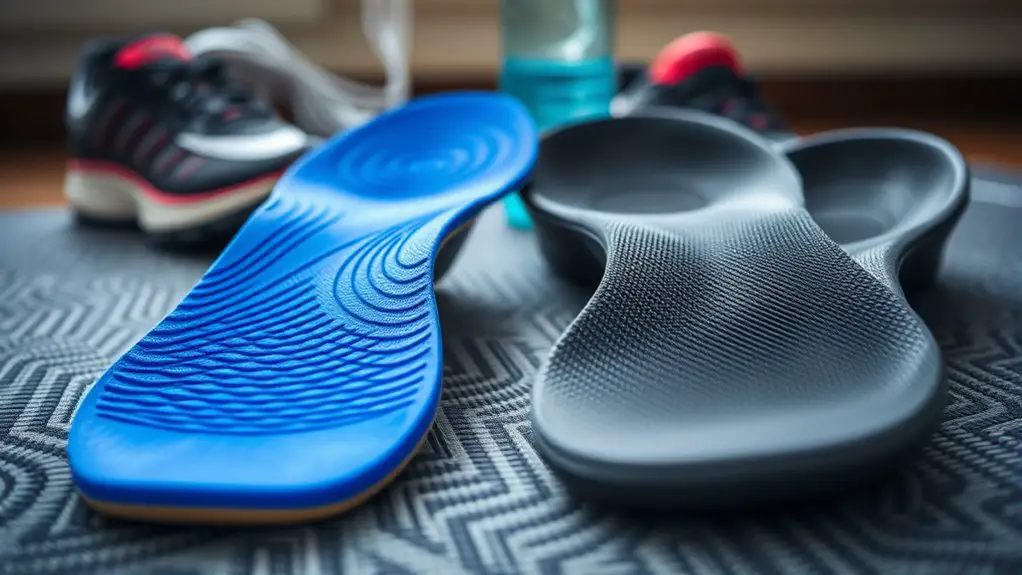Post-workout stretching is essential for your recovery and performance. Focus on static stretches to reduce soreness and enhance flexibility—hold each for 15-30 seconds. Incorporate dynamic stretches like leg swings before workouts to improve your range of motion. Target major muscle groups, including hamstrings and shoulders, for thorough relief. Don't forget foam rolling to release tension and boost blood flow. If you're looking to craft a personalized stretching plan, there's more you can explore.
The Importance of Post-Workout Stretching
While you might feel tempted to skip stretching after a workout, it's essential for your recovery and overall performance. Stretching helps maintain your flexibility, which can enhance your range of motion and allow you to move freely, whether you're hitting the gym or enjoying outdoor adventures. It also aids in reducing muscle soreness and stiffness, letting you bounce back quicker for your next session. By incorporating post-workout stretches, you're actively promoting better blood circulation, which helps deliver nutrients to your muscles. Plus, it's a great way to unwind and connect with your body after pushing it to its limits. Embrace this time for yourself; it's not just about the workout, but about preparing your body for the freedom of movement ahead.
Static Stretching Techniques for Recovery
After you've pushed your body through a tough workout, incorporating static stretching techniques can greatly enhance your recovery. These stretches help lengthen your muscles and improve flexibility, reducing soreness and the risk of injury. Focus on holding each stretch for 15 to 30 seconds, breathing deeply to promote relaxation. Target areas that feel tight, like hamstrings, quadriceps, and shoulders. You might enjoy seated forward bends or standing quadriceps stretches, as they allow you to unwind while you listen to your body. Don't rush; take your time to feel the release in your muscles. By making static stretching a part of your routine, you'll embrace a more liberated sense of movement and liveliness in your athletic pursuits.
Dynamic Stretching for Enhanced Flexibility
Dynamic stretching plays an essential role in enhancing flexibility and preparing your body for athletic performance. Unlike static stretches, dynamic movements engage your muscles and joints, increasing blood flow and improving range of motion. Think about incorporating leg swings, arm circles, or high knees into your routine. These movements not only warm you up but also prime your body for the challenges ahead. You're not just stretching; you're activating your muscles, making them more responsive during your workout. Aim for 10-15 minutes of dynamic stretching before hitting the field or gym. It'll help you feel more agile and ready, giving you the freedom to move without restriction. So, embrace dynamic stretching and unleash your body's potential for peak performance!
Targeted Stretching for Major Muscle Groups
To maximize your athletic performance, incorporating targeted stretching for major muscle groups is essential. This practice not only enhances flexibility but also promotes recovery and reduces the risk of injury. Focus on the following key muscle groups:
- Hamstrings: Stretching these can alleviate tightness and improve your stride.
- Quadriceps: A good quad stretch helps maintain knee health and overall leg strength.
- Hip Flexors: Loosening these muscles can enhance mobility and reduce lower back strain.
- Shoulders: Targeting shoulder flexibility can improve upper body performance and reduce tension.
Incorporating Foam Rolling Into Your Routine
While stretching is essential for recovery, incorporating foam rolling into your routine can take your post-workout recovery to the next level. Foam rolling helps release muscle tension, improve blood flow, and enhance flexibility. By targeting those stubborn knots and tight spots, you can feel more freedom in your movements. After your workout, spend a few minutes rolling over major muscle groups like your quads, hamstrings, and back. Don't rush; listen to your body and hold on areas that need extra attention. You'll find that this self-myofascial release method complements your stretching, allowing you to recover faster and perform better. Plus, it's an empowering way to connect with your body, helping you access your full athletic potential.
Crafting a Personalized Stretching Plan
After incorporating foam rolling into your recovery routine, it's time to focus on crafting a personalized stretching plan that suits your specific needs. By tailoring your stretches, you can enhance flexibility, prevent injuries, and improve your overall performance. Here's how to get started:
- Identify muscle groups: Pinpoint areas that feel tight or sore after workouts.
- Choose dynamic and static stretches: Mix both types to warm up and cool down effectively.
- Consider your sport: Adapt stretches based on the demands of your specific activity, whether it's running, cycling, or weightlifting.
- Listen to your body: Adjust your plan based on how your muscles respond, ensuring you always feel good while stretching.
Embrace the freedom of movement and find what feels right for you!
Frequently Asked Questions
How Long Should I Hold Each Stretch?
You should hold each stretch for about 15 to 30 seconds. It's important to find a balance—you don't want to rush, but you also don't want to overdo it. Listen to your body!
Can Stretching Prevent Injuries?
Stretching can help improve flexibility, enhance range of motion, and reduce muscle tension. While it's not a foolproof way to prevent injuries, it certainly contributes to overall body awareness and prepares you for movement.
Is It Okay to Stretch Before a Workout?
Yeah, it's okay to stretch before a workout, especially if you warm up first. Dynamic stretches can enhance your performance and flexibility. Just avoid static stretching, as it might reduce your strength temporarily.
What Are the Benefits of Foam Rolling?
Foam rolling's great for releasing muscle tension and improving circulation. It helps reduce soreness, enhances flexibility, and can boost recovery. You'll feel more relaxed and ready for your next workout, enjoying greater freedom in movement.
Should I Stretch if I'm Sore?
If you're sore, stretching can help ease tension and improve flexibility. Just listen to your body; gentle stretches might feel good, but don't push too hard. Recovery's important, so be kind to yourself.




